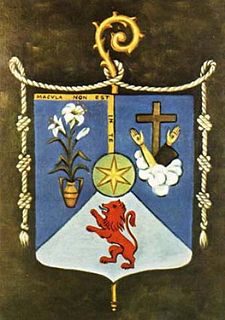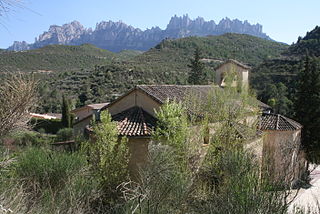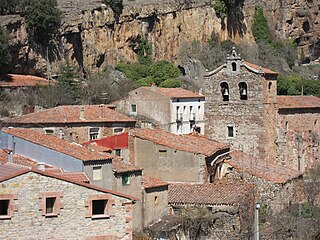
John of the Cross was a major figure of the Counter-Reformation, a Spanish mystic, a Roman Catholic saint, a Carmelite friar and a priest, who was born at Fontiveros, Old Castile.

The Royal Abbey of Santa Maria de Poblet is a Cistercian monastery, founded in 1151, located at the foot of the Prades Mountains, in the comarca of Conca de Barberà, in Catalonia (Spain). It was founded by Cistercian monks from France on lands conquered from the Moors. The main architect was Arnau Bargués.

San Lorenzo de El Escorial, also known as El Escorial de Arriba is a town and municipality in the Community of Madrid, Spain, located to the northwest of the region in the southeastern side of the Sierra de Guadarrama, at the foot of Mount Abantos and Las Machotas, 47 kilometres (29 mi) from Madrid. It is head of the same name judicial party. The settlement is popularly called El Escorial de Arriba, to differentiate it from the neighbouring village of El Escorial, also known as El Escorial de Abajo.

The Order of Saint Jerome or Hieronymites is a Catholic cloistered religious order and a common name for several congregations of hermit monks living according to the Rule of Saint Augustine, though the inspiration and model of their lives is the 5th-century hermit and biblical scholar Saint Jerome.

The Order of the Immaculate Conception, also known as the Conceptionists, are a contemplative religious order of nuns. For some years, they followed the Poor Clares Rule, but in 1511 were recognized as a separate Catholic religious order, taking a new Rule and the name of Order of Immaculate Conception.

Marganell is a municipality in the comarca of the Bages in Catalonia, Spain. It is situated on the northern slopes of Montserrat, and is also known as Santa Cecília de Montserrat in reference to the Benedictine monasteries. The agriculture in the municipality is mostly of cereals, and the majority of the active population works elsewhere.

Alfauir is a municipality in the comarca of Safor in the Valencian Community, Spain.

Simat de la Valldigna is a municipality in the comarca of Safor in the Valencian Community, Spain. It is 50 km from Valencia, and 20 km from Cullera and Gandia. It is also near Xàtiva and Alzira.

Sahagún is a town in the province of León, Spain. It is the main town of the Leonese section of the Tierra de Campos district.

Alfonso X of Castile, also known as Alfonso the Learned, ruled from 1252 until 1284. One of Alfonso’s goals for his kingdom was to lift Spain out of the Dark Ages by producing a united, educated, artistic, and religious population. His desire to bring Spain into the mainstream of high civilization led to a boom of cultural activity, including the production and translation of a great deal of literature. The literature produced during his reign was intended to aid him in achieving his goal by giving the common people of Spain access to great intellectual works. Therefore, all of the prose attributed to Alfonso X’s efforts was written in the language of the common people, Castilian, rather than Latin, which was the language of prestige at that time. Although the works are generally attributed to Alfonso X, being a king with other business to deal with he did not himself write most of them. Instead, Alfonso’s role was that of choosing works to be produced and translated, funding the projects, selecting the true authors of the work, overseeing the production, and occasionally contributing personally.

Valbuena Abbey is a former Cistercian monastery in Valbuena de Duero in Valladolid Province, Castile-Leon, Spain. It stands on the right bank of the Duero, within sight of the royal castle of Peñafiel.

La Serranía is a comarca in the province of Guadalajara, central Spain, with the capital in the city of Sigüenza. It is one of the less populated regions in Europe. La Serranía is home to monumental villages such as Anguita, Atienza, Luzón, Palazuelos.

The monasteries of San Millán de Suso and San Millán de Yuso are two monasteries situated in the village of San Millán de la Cogolla, La Rioja, Spain. They have been designated a World Heritage Site by UNESCO since December 1997.

St Dominic's monastery is a former Dominican monastery in Santiago de Compostela, Galicia, Spain.

Santa María de Óvila is a former Cistercian monastery built in Spain beginning in 1181 on the Tagus River near Trillo, Guadalajara, about 90 miles (140 km) northeast of Madrid. During prosperous times over the next four centuries, construction projects expanded and improved the small monastery. Its fortunes declined significantly in the 18th century, and in 1835 it was confiscated by the Spanish government and sold to private owners who used its buildings to shelter farm animals.

Domingo Antonio de Andrade (Cee, 1639 – Santiago de Compostela, 1712 was a Galician baroque architect, a leading figure in the emergence of Galician Baroque architecture.
Bernal(do) de Bonaval(le), also known as Bernardo (de) Bonaval, was a 13th-century troubadour in the Kingdom of Galicia who wrote in the Galician-Portuguese language.





















